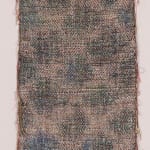



Consuelo Jimenez Underwood American, b. 1949
Mother Rain Rebozo, 2017
Woven, painted warp. Pattern and tapestry weaves. Linen, metallic, silk, and wool thread
67.25 x 15 in
170.8 x 38.1 cm
170.8 x 38.1 cm
Further images
When Consuelo Jimenez Underwood began this rebozo in 2017, California was six years into an intense drought. Not wanting to ask too much of Mother Rain, she began the weaving...
When Consuelo Jimenez Underwood began this rebozo in 2017, California was six years into an intense drought. Not wanting to ask too much of Mother Rain, she began the weaving as an offering. In words of Jimenez Underwood, "California needed rain. The serpent is associated with Rain in many American Indigenous cultures. A handsome handwoven Mexican Indigenous shawl is a highly prized textile. I wove rain prayers into a rebozo-portrait for Mother Rain, a quid pro quo. I resist-painted and wove unbleached linen in a Herringbone pattern, a basic universal weave structure. The lower body area evokes serpentine skin qualities, reflection, pattern repetition, and movement. At the top is her portrait, tapestry woven with wool threads. Her eyes, nose, and teeth remain hidden. Remarkably, the drought ended before Jimenez Underwood finished the offering. In fact, “when the work was almost completed, the Oroville Dam in Northern California overflowed.”
"In Mother Rain Rebozo, the artist is signaling the consequences of ecological damage and climate change by commemorating the costly California drought, which lasted from 2011 to 2017. At the same time, in the syncretic fashion that underscores Jimenez Underwood's notion of the interconnectedness of all life across all imposed (b)orders, Mother Rain pays homage to the rain serpent and in so doing drives curious onlookers to discover that the rain serpent might be traced to a number of Indigenous cosmologies." Carmen Febles, "Reading our Mothers," Consuelo Jimenez Underwood: Art Weaving, Vision, Duke University Press, 2022
"In Mother Rain Rebozo, the artist is signaling the consequences of ecological damage and climate change by commemorating the costly California drought, which lasted from 2011 to 2017. At the same time, in the syncretic fashion that underscores Jimenez Underwood's notion of the interconnectedness of all life across all imposed (b)orders, Mother Rain pays homage to the rain serpent and in so doing drives curious onlookers to discover that the rain serpent might be traced to a number of Indigenous cosmologies." Carmen Febles, "Reading our Mothers," Consuelo Jimenez Underwood: Art Weaving, Vision, Duke University Press, 2022
Exhibitions
Consuelo Jimenez Underwood: Threads from Border-landia, Ruiz-Healy Art, New York, NY, 2022Consuelo J. Underwood: Thread Songs from the Borderlands, 108 Contemporary, Tulsa, OK, 2018
Mano-Made: New Expression in Craft by Latino Artists, Consuelo Jimenez Underwood, Craft in America Center, Los Angeles, CA; curator: Emily Zaiden, 2017
Literature
Laura E. Perez and Ann Marie Leimer, eds., Consuelo Jimenez Underwood: Art, Weaving, Vision, Durham, North Carolina: Duke University Press, 2022, between pages 160-161 (illustrated)
Mano-Made: New Expression in Craft by Latino Artists, Consuelo Jimenez Underwood, Craft in America, 2017, p. 20 (illustrated)



